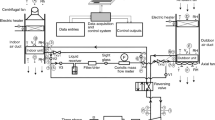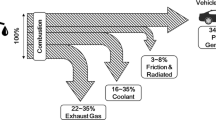Abstract
Excavators perform high-load operations in mainly a fixed place, and the heat balance is determined by the performance of the cooling system. Prediction of the cooling system performance is difficult due to non-uniformity of the air flow field inside the engine room and complicated boundary conditions. In the present study, CFD analysis of the engine room was performed for a preliminary evaluation of the cooling system performance of an excavator, and the analysis technique was validated by comparison with heat balance test results for an actual vehicle. CFD analysis was performed according to the design of experiment method for three types of internal design variables and two types of external design variables. A sensitivity analysis of the engine room design variables was performed and a regression model for the major design variables was proposed. Based on the regression model, optimization was conducted for the engine room layout for performance improvement.
Similar content being viewed by others
References
F. G. Rising, Engine Cooling System Design for Heavy Duty Trucks (1977) SAE770023.
E. C. Chiang, V. J. Ursini and J. H. Johnson, Development and Evaluation of a Diesel-Powered Truck Cooling System Computer Simulation Program (1982) SAE821048.
J. A. Sidders and D. G. Tilley, Optimizing Cooling System Performance Using Computer Simulation (1997) SAE971802.
O. Arici, J. H. Johnson and A. J. Kulkarni, The Vehicle Engine Cooling System Simulation Part 1 - Model Development (1999) SAE1999–01–240.
O. Arici, J. H. Johnson and A. J. Kulkarni, The Vehicle Engine Cooling System Simulation Part 2 - Model Validation Using Transient Data (1999) SAE1999–01–241.
X. J. Chen, Simulation research of engine cooling system, Advanced Materials Research, 442 (2012) 224–228.
K. G. Mahmoud, E. Loibner and B. Wiesler, Simulation-Based Vehicle Thermal Management System \3- Concept and Methodology (2003) SAE2003–01–0276.
V. P. Malapure and S. K. Mitra, Numerical investigation of fluid flow and heat transfer over louvered fins in compact heat exchanger, International Journal of Thermal Sciences, 46 (2007) 199–211.
Z. G. Qi and J. P. Chen, Parametric study on the performance of a heat exchanger with corrugated louvered fins, Applied Thermal Engineering, 27 (2007) 539–544.
M. M. A. Bhutta, N. Hayat, N. M. H. Bashir, A. R. Khan, K. N. Ahmad and S. Khan, CFD applications in various heat exchangers design: A review, Applied Thermal Engineering, 32 (2012) 1–12.
C. H. Jeong. H. R. Kim, M. Y. Ha, S. W. Son, J. S. Lee and P. Y. Kim, Numerical investigation of thermal enhancement of plate fin type heat exchanger with creases and holes in construction machinery, Applied Thermal Engineering, 62 (2014) 529–544.
C. Eric, D. Bruno, M. Stephane, B. Robert and B. Farid, CFD Based Design for Automotive Engine Cooling Fan System (1998) SAE Paper 980427.
N. S. Ap, P. Guerrero and P. Jouanny, Influence of Front end Vehicle, Fan and Shroud on the Heat Performance of A/C Condenser and Cooling Radiator (2002) SAE2002–01–1206.
N. Liu, X. Lai, K. Yan and H. Zhang, Investigation of flow and heat transfer characteristics on different heat exchangers of air conditioner, Applied Thermal Engineering, 103 (2016) 428–433.
R. Nageswara, K. Sukhvinder, K. Ravi and K. Niranjan, CFD Analysis of Axial Flow Fans for Radiator Cooling in Automobile Engines (2007) SAE2007–01–4262.
N. Katoh, T. Ogawa and T. Kuriyama, Numerical Simulation on the Three-dimensional Flow and Heat Transfer in the Engine Compartment (1991) SAE910306.
H. Shimonosono, Y. Shibata and K. Fujitani, Optimization of the Heat Flow Distribution in the Engine Compartment (1993) SAE930883.
B. Uhl, F. Brotz, J. Fauser and U. Kruger, Development of Engine Cooling System by Coupling CFD Simulation and Heat Exchanger Analysis Programs (2001) SAE2001–01–1695.
A. Jerhamre and A. Jonson, Development and Validation of Coolant Temperature and Cooling Air Flow CFD Simulations at Volvo Cars (2004) SAE2004–01–0051.
A. Alajbegovic, B. Xu, A. Konstantinov and J. Amodeo, Simulation of Cooling Airflow under Different Driving Conditions (2007) SAE2007–01–0766.
T. Hallqvist, The Cooling Airflow of Heavy Trucks - A Parametric Study (2008) SAE2008–01–1171.
H. R. Kim, Y. M. Seo, M. Y. Ha, J. S. Lee and P. Y. Kim, Numerical study on the engine room cooling performance of a medium size excavator, Progress in Computational Fluid Dynamics, An International Journal, 19 (3) (2019) 191–203.
K. Vafai, Handbook of Porous Media, Taylor & Francis (2005) 106–112.
Fluent Inc., Fluent 6.2 User Guide.
Minitab Inc., Minitab 17 User Guide.
Institute of Design Optimization Inc., Easy Design User Guide.
Acknowledgments
This research was supported by Basic Science Research Program through the National Research Foundation of Korea (NRF) funded by the Ministry of Education, Science and Technology (NRF-2017R1A2B3004883).
Author information
Authors and Affiliations
Corresponding author
Additional information
Recommended by Associate Editor Seongwon Kang
Man Yeong Ha had his undergraduate degree from Pusan National University, Korea in 1981, his master degree from Korea Advanced Institute of Science and Technology, S. Korea in 1983, and his Ph.D. degree from Pennsylvania State University, USA in 1990. Dr. Ha is currently a Professor at the School of Mechanical Engineering, Pusan National University in Busan, S. Korea. He is an Editor of the Journal of Mechanical Science and Technology. His research interests are focused on thermal heat management, computational fluid dynamics, and finite volume method using hybrid scheme.
Jae Seok Lee had his B.S. in mechanical engineering from Pusan National University, S. Korea in 2003 and his M.S. in mechanical engineering from Seoul National University, S. Korea in 2005. He is currently a Senior Researcher in Hyundai Construction Equipment in S. Korea. His research interests are focused on virtual validation and performance improvement of cooling and hydraulic systems for construction equipment.
Rights and permissions
About this article
Cite this article
Lee, J.S., Seo, Y.M., Jeong, C.H. et al. Numerical analysis and design optimization of engine room to improve cooling performance for a mid-class excavator. J Mech Sci Technol 33, 3265–3275 (2019). https://doi.org/10.1007/s12206-019-0622-5
Received:
Revised:
Accepted:
Published:
Issue Date:
DOI: https://doi.org/10.1007/s12206-019-0622-5




